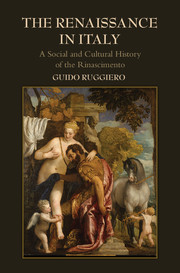Book contents
- Frontmatter
- Dedication
- Contents
- List of Illustrations
- Acknowledgments
- Maps
- Introduction: The End of the World and Its Rebirth (Rinascita) as the Rinascimento
- 1 Legitimacy: A Crisis and a Promise (c. 1250–c. 1340)
- 2 Civiltà: Living and Thinking the City (c. 1300–c. 1375)
- 3 Plague: Death, Disaster, and the Rinascita of Civiltà (c. 1325–c. 1425)
- 4 Violence: Social Conflict and the Italian Hundred Years’ War (c. 1350–1454)
- 5 Imagination: The Shared Primary Culture of the Early Rinascimento (c. 1350–c. 1475)
- 6 Courts: Princes, Aristocrats, and Quiet Glory (c. 1425–c. 1500)
- 7 Self: The Individual as a Work of Art (c. 1425–c. 1525)
- 8 Discovery: Finding the Old in the New (c. 1450–c. 1560)
- 9 Re-Dreams: Virtù, Saving the Rinascimento, and the Satyr in the Garden (c. 1500–c. 1560)
- 10 Reform: Spiritual Enthusiasms, Discipline, and a Church Militant (c. 1500–c. 1575)
- 11 Retreat: The Great Social Divide and the End of the Rinascimento (c. 1525–c. 1575)
- Epilogue: The Diaspora of the Rinascimento
- Bibliography: A Short List of Works Used
- Index
5 - Imagination: The Shared Primary Culture of the Early Rinascimento (c. 1350–c. 1475)
Published online by Cambridge University Press: 05 December 2014
- Frontmatter
- Dedication
- Contents
- List of Illustrations
- Acknowledgments
- Maps
- Introduction: The End of the World and Its Rebirth (Rinascita) as the Rinascimento
- 1 Legitimacy: A Crisis and a Promise (c. 1250–c. 1340)
- 2 Civiltà: Living and Thinking the City (c. 1300–c. 1375)
- 3 Plague: Death, Disaster, and the Rinascita of Civiltà (c. 1325–c. 1425)
- 4 Violence: Social Conflict and the Italian Hundred Years’ War (c. 1350–1454)
- 5 Imagination: The Shared Primary Culture of the Early Rinascimento (c. 1350–c. 1475)
- 6 Courts: Princes, Aristocrats, and Quiet Glory (c. 1425–c. 1500)
- 7 Self: The Individual as a Work of Art (c. 1425–c. 1525)
- 8 Discovery: Finding the Old in the New (c. 1450–c. 1560)
- 9 Re-Dreams: Virtù, Saving the Rinascimento, and the Satyr in the Garden (c. 1500–c. 1560)
- 10 Reform: Spiritual Enthusiasms, Discipline, and a Church Militant (c. 1500–c. 1575)
- 11 Retreat: The Great Social Divide and the End of the Rinascimento (c. 1525–c. 1575)
- Epilogue: The Diaspora of the Rinascimento
- Bibliography: A Short List of Works Used
- Index
Summary
One thing is clear when we look at the cultural world of the early Rinascimento. There were no humanists. And the supposedly central cultural accomplishment of the period, humanism, was unknown. It simply did not exist. The term was coined only in the nineteenth century by a German teacher in the Gymnasium, as the great twentieth-century scholar of the subject Paul Oscar Kristeller pointed out long ago. The label “humanist,” however, did begin to be used in the late fifteenth century, apparently first by university students to refer to professors who focused on the studia humanitatis – that is, grammar, rhetoric, history, poetry, and moral philosophy – rather than on theology and law.
Less obvious, but in many ways more significant, is the way the search for humanism and humanists in the early Rinascimento, before they existed, has skewed the way scholars have looked at the cultural world of the fourteenth and fifteenth centuries. Perhaps most importantly, it has created a canon of works and writers who are deemed to be pre-humanistic or even simply humanist that seriously distorts the range and complexity of the cultural world of the day. Moreover, many writers and thinkers have largely been overlooked (or consigned to the Middle Ages, a kind of humanist hell) by scholars because they do not fit into the anachronistic and rather procrustean mold of an imagined humanism. In turn, many luminaries who have made it into the canon have become curiously disjointed by a scholarly desire to highlight their supposed humanistic writings at the expense of their broader oeuvre.
- Type
- Chapter
- Information
- The Renaissance in ItalyA Social and Cultural History of the Rinascimento, pp. 205 - 267Publisher: Cambridge University PressPrint publication year: 2014



